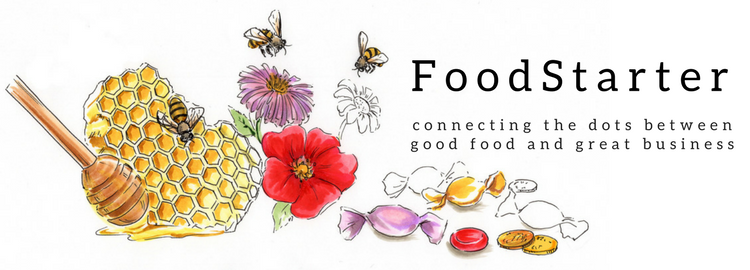Guest Post by Michael Adams, founder of Green Mountain Mustard.
I’ve been producing food products for over 10 years, starting as a home baker. And in these 10 years, I’ve had my fair share or production nightmares. My first two food companies were baked goods — cookies and energy bars. I chose to make products like these for a simple reason: I could produce them in my parent’s home kitchen. (In Vermont, the state health department required a mere $50 for a home bakery license.)
Producing food at home can look like “the dream” but it can get crazy, quickly. Family interruptions, ingredients strewn everywhere, and the oven on 24/7. You may quickly struggle to keep up with demand given the constraints of your tiny home kitchen. And what about your ingredient management – is it under control?
Processing large amounts of product outside your home comes with its own challenges: scaling recipes correctly, getting a scheduled process, and making sure you maintain your product quality, just to name a few.
These challenges can be overwhelming if you’re just starting out.
Here are five common problems I’ve encountered and how I solved them. Hopefully what I’ve learned helps you transition to a bigger commercial kitchen to grow your food business.
Do any of these ring a bell?
1. Packaging unknowns
Both of my baked goods companies had the same problem: Packaging was the constant unknown. I had no idea what I was doing, what equipment I needed, and how my packaging decisions would affect my fresh-baked product’s shelf-life.
My solution:
After a few tries I got it down: To start-out, I used a heat sealer with polypropylene bags. Product would go in the bag, the bag would be sealed, and then hand-labeled. It worked well for the first 18 months. But packaging was taking far too long and the seals didn’t stay sealed. What to do? We purchased a horizontal band sealer on eBay. (The same company makes vertical band sealers for packaging things like nuts and pretzels.) The sealer better closed the poly bags by locking out air, extending our shelf life by a few days. And a few days can make a big difference between profit and loss!
2. Making a food product with fresh eggs
Sometimes your product fits into special “rules” because it uses perishable or “potentially hazardous” ingredients which, in other words, could make people sick, or worse. I currently own a mustard company. We use eggs and butter in the majority of our line. That means our product not only required a unique scheduled process, but production was different, too. It wasn’t as simple as “dump and fill,” which describes the usual way you’d fill mustard jars. We had to make sure our temperature was consistent.
My solution:
First, I consulted with a food processing authority. While there aren’t tons of them, they’re lifesavers in terms of expertise. I’ve had a great experience working with the team at Cornell’s Food Science Lab. To make sure we kept the temperature at the right point, I did several things:
- made smaller batches to control the temperature as we moved throughout the kitchen,
- water-bathed the jars to for 30 minutes to bring them up to temp, and
- made sure to record everything in case we had a bad temperature and had to head back to the kettle.
3. Better production forecasting
I’ve been completely cleared out of product several times this year. Yes, it’s a good problem to have, but the uncertainty keeps me on edge. When you start getting large orders out of the blue, it’s an even better problem to have but planning for production gets even more challenging. Sure, you can go off of last year’s numbers, but what if you don’t have any numbers? How do you forecast to make sure you don’t run out of product?
My solution:
Work with an average sales number. If you do a farmer’s market and average $600/market, plan for that. If you’d like to add 10 retailers a month, what’s the average order? Plus, how often will retailers reorder? Add that into your production needs for the month. This gives you a better idea of what you need for the month. And don’t forget: if you have an event like a fair or festival coming up, plan for that, too. For every 5,000 people at the event, we sample a lot and typically sell 75 units or so. But, every food business is different!
4. Finding a co-packer to make your product
I’m a sales and marketing guy at heart. And many of you probably are, too. Sales and marketing is the engine that’s going to grow your food business. To devote enough time to selling my product (the last thing I want is to have expired product sitting on the shelf), you may need to consider finding a co-packer unless you have your own production team. But, as with everything, locating a co-packer can be one the most time-consuming decisions for your business.
My solution:
I found my first co-packer through a Google search. She was located about an hour from my parent’s house and had a great-looking facility. While we packed with her for about a year, it was incredibly expensive and I wasn’t making a healthy profit margin. Things had to change. I found my second co-packer through word-of-mouth. The food community will share anything with you – co-packer referrals, ingredient sources, fairs & festivals, etc. We’ve happily been with our co-packer for over two years. As for numbers, we produce bi-weekly – around 100-150 cases a month. I manage the ingredient inventory and assist in a production a month to make sure everything is going smoothly.
5. Managing all the moving parts of your food business
With any small business, you wear a lot of hats. You’ve got to handle labels, production, sales, marketing, cleaning, accounting, demos, sending samples — the list goes on. And many small business owners still think they can do it all themselves. Luckily there are many low cost tools out there to help you manage every aspect of your business. Here are a few more I like:
How I solved it:
- For reporting, brainstorming, and craft show planning, I use Google Drive. You can work from anywhere!
- For my website and blog I use WordPress. [Note from Susie: I do too, on BlueHost and am happy to share tips.]
- I design my own labels using Adobe Photoshop and print them at a local company.
- For social media (Facebook, Twitter etc) I use Hootsuite, accessible via your computer or smartphone app. Hootsuite gives you a central way to manage all your updates.
Certainly, there are more than 5 problems small food businesses experience. What are your top challenges? Let me know in the comments below and I’d be happy to help solve your problem – whether it’s production, marketing, getting new retailers, I’m all ears!
Author Bio: Michael Adams runs Green Mountain Mustard, available in over 100 retailers across New England.







Marketing is my biggest challenge. Any suggestions?
Hi Dolores,
The more you can sample your cakes, the better. Cakes are so great fresh, I wonder if there are companies who might use your mini cakes for meeting snacks? Just another way to get more people to sample them.
On your website it would be great to see testimonials or quotes front and center, for those who don’t have the pleasure of sampling locally.
Hope these little ideas spark good things for you!
Susie
Hi Dolores,
The more you can sample your cakes, the better. Cakes are so great
fresh, I wonder if there are companies who might use your mini cakes for
meeting snacks? Just another way to get more people to sample them.
On your website it would be great to see testimonials or quotes front
and center, for those who don’t have the pleasure of sampling locally.
Hope these little ideas spark good things for you!
Susie
Hi! I am just starting to think about packaging my protein bars. I have the recipe, but now need to package. I’ve contacted large production/packaging/distribution facilities already, which seem to be a pretty good deal with being able to produce small to large quantities at a time. Then, that just leaves us with the marketing and getting our product out there. So, my question is, is this a good route to take just starting out, or should I order the food sealers and plastic tubing and just package them myself for now if it might be a lot more cost effective? Thank you for any help!
Hi Corrine,
It depends if you are up for the challenge (time, money, energy) of making food yourself, the expense of renting a kitchen or getting licensed to make it at home (if you’re allowed), and if you have the perfection required to make something that people will want to buy. Starting out with a co-packer will help you test what the ultimate product will be. I’m guessing that if they’re good you’ll be able to sell them somehow if only to friends and family.
So if you think it sounds like a good deal to produce a small quantity and they can make the bars the way you want, I’d go that route. Hope this helps!
Susie